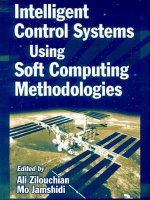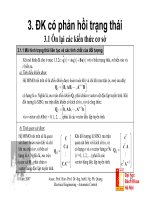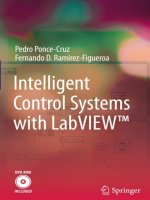intelligent control systems using soft computing methodologies
Bạn đang xem bản rút gọn của tài liệu. Xem và tải ngay bản đầy đủ của tài liệu tại đây (11.48 MB, 493 trang )
Intelligent
Control Systems
Using
Soft Computing
Methodologies
Boca Raton London New York Washington, D.C.
CRC Press
Intelligent
Control Systems
Using
Soft Computing
Methodologies
Edited by
Ali Zilouchian
Mo Jamshidi
This book contains information obtained from authentic and highly regarded sources. Reprinted material
is quoted with permission, and sources are indicated. A wide variety of references are listed. Reasonable
efforts have been made to publish reliable data and information, but the author and the publisher cannot
assume responsibility for the validity of all materials or for the consequences of their use.
Neither this book nor any part may be reproduced or transmitted in any form or by any means, electronic
or mechanical, including photocopying, microfilming, and recording, or by any information storage or
retrieval system, without prior permission in writing from the publisher.
All rights reserved. Authorization to photocopy items for internal or personal use, or the personal or
internal use of specific clients, may be granted by CRC Press LLC, provided that $.50 per page
photocopied is paid directly to Copyright Clearance Center, 222 Rosewood Drive, Danvers, MA 01923
USA. The fee code for users of the Transactional Reporting Service is ISBN 0-8493-1875-
0/01/$0.00+$.50. The fee is subject to change without notice. For organizations that have been granted
a photocopy license by the CCC, a separate system of payment has been arranged.
The consent of CRC Press LLC does not extend to copying for general distribution, for promotion, for
creating new works, or for resale. Specific permission must be obtained in writing from CRC Press LLC
for such copying.
Direct all inquiries to CRC Press LLC, 2000 N.W. Corporate Blvd., Boca Raton, Florida 33431.
Trademark Notice:
Product or corporate names may be trademarks or registered trademarks, and are
used only for identification and explanation, without intent to infringe.
Visit the CRC Press Web site at www.crcpress.com
© 2001 by CRC Press LLC
No claim to original U.S. Government works
International Standard Book Number 0-8493-1875-0
Library of Congress Card Number 2001016189
Printed in the United States of America 1 2 3 4 5 6 7 8 9 0
Printed on acid-free paper
Library of Congress Cataloging-in-Publication Data
Intelligent control systems using soft computing methodologies / edited by Ali
Zilouchian and Mohammad Jamshidi.
p. cm.
Includes bibliographical references and index.
ISBN 0-8493-1875-0
1. Intelligent control systems—Data processing. 2. Soft computing. I. Zilouchian, Ali.
II. Jamshidi, Mohammad.
TJ217.5 .I5435 2001
629.89
′
0285
′
63—dc21 2001016189
To my late grandfather, Gholam-Reza for his devotion to science and
humanitarian causes
A. Zilouchian
To my family, Jila, Ava and Nima for their love and patience
M. Jamshidi
PREFACE
Since the early 1960s, artificial intelligence (AI) has found its way into
industrial applications − mostly in the area of expert knowledge-based decision
making for the design and monitoring of industrial products or processes. That
fact has been enhanced with advances in computer technology and the advent
of personal computers, and many applications of intelligence have been
realized. With the invention of fuzzy chips in the1980s, fuzzy logic received a
high boost in industry, especially in Japan. In this country, neural networks and
evolutionary computations were also receiving unprecedented attention in both
academia and industry. As a result of these events, “soft computing” was born.
Now at the dawn of the 21
st
century, soft computing continues to play a
major role in modeling, system identification, and control of systems − simple
or complex. The significant industrial uses of these new paradigms have been
found in the U.S.A and Europe, in addition to Japan. However, to be able to
design systems having high MIQ® (machine intelligence quotient, a concept
first introduced by Lotfi Zadeh), a profound change in the orientation of
control theory may be required.
The principal constituents of soft computing are fuzzy logic,
neurocomputing, genetic algorithms, genetic programming, chaos theory, and
probabilistic reasoning. One of the principal components of soft computing is
fuzzy logic. The role model for fuzzy logic is the human mind. From a control
theoretical point of view, fuzzy logic has been intermixed with all the
important aspects of systems theory: modeling, identification, analysis,
stability, synthesis, filtering, and estimation. Interest in stability criteria for
fuzzy control systems has grown in recent years. One of the most important
difficulties with the creation of new stability criteria for any fuzzy control
system has been the analytical interpretation of the linguistic part of fuzzy
controller IF-THEN rules. Often fuzzy control systems are designed with very
modest or no prior knowledge of a solid mathematical model, which, in turn,
makes it relatively difficult to tap into many tools for the stability of
conventional control systems. With the help of Takagi-Sugeno fuzzy IF-THEN
rules in which the consequences are analytically derived, sufficient conditions
to check the stability of fuzzy control systems are now available. These
schemes are based on the stability theory of interval matrices and those of the
Lyapunov approach. Frequency-domain methods such as describing functions
are also being employed for this purpose.
This volume constitutes a report on the principal elements and important
applications of soft computing as reported from some of the active members of
this community. In its chapters, the book gives a prime introduction to soft
computing with its principal components of fuzzy logic, neural networks,
genetic algorithms, and genetic programming with some textbook-type
problems given. There are also many industrial and development efforts in the
applications of intelligent systems through soft computing given to guide the
interested readers on their research interest track.
This book provides a general foundation of soft computing methodologies as
well as their applications, recognizing the multidisciplinary nature of the
subject. The book consists of 21 chapters, organized as follows:
In Chapter 1, an overview of intelligent control methodologies is presented.
Various design and implementation issues related to controller design for
industrial applications using soft computing techniques are briefly discussed in
this chapter. Furthermore, an overall evaluation of the intelligent systems is
presented therein.
The next two chapters of the book focus on the fundamentals of neural
networks (NN). Theoretical as well as various design issues related to NN are
discussed. In general, NN are composed of many simple elements emulating
various brain activities. They exploit massive parallel local processing and
distributed representation properties that are believed to exist in the brain. The
primary purpose of NN is to explore and produce human information
processing tasks such as speech, vision, knowledge processing, and motor
control. The attempt of organizing human information processing tasks
highlights the classical comparison between information processing
capabilities of the human and so called hard computing. The computer can
multiply large numbers at fast speed, yet it may not be capable to understand
an unconstrained pattern such as speech. On the other hand, though humans
understand speech, they lack the ability to compute the square root of a prime
number without the aid of pencil and paper or a calculator. The difference
between these two opposing capabilities can be traced to the processing
methods which each employs. Digital computers rely upon algorithm-based
programs that operate serially, are controlled by CPU, and store the
information at a particular location in memory. On the other hand, the brain
relies on highly distributed representations and transformations that operate in
parallel, have distributed control through billions of highly interconnected
neurons or processing elements, and store information in various straight
connections called synapses. Chapter 2 is devoted to the fundamental issues
above. In Chapter 3, supervised learning with emphasis on back propagation
and radial basis neural functions algorithms is presented. This chapter also
addresses unsupervised learning (Kohonen self-organization) and recurrent
networks (Hopfield).
In Chapters 4
−
−−
−
7, several applications of neural networks are presented in
order to familiarize the reader with design and implementation issues as well as
applicability of NN to science and engineering. These applications areas
include medicine and biology (Chapter 4), digital signal processing (Chapter
5), computer networking (Chapter 6), and oil refinery (Chapter 7).
Chapters 8, 9 and 10 of the book are devoted to the theoretical aspect of
fuzzy set and fuzzy logic (FL). The main objective of these three chapters is to
provide the reader with sufficient background related to implementation issues
in the following chapters. In these chapters, we cover the fundamental concepts
of fuzzy sets, fuzzy relation, fuzzy logic, fuzzy control, fuzzification,
defuzification, and stability of fuzzy systems.
As is well known, the first implementation of Professor Zadeh’s idea
pertaining to fuzzy sets and fuzzy logic was accomplished in 1975 by
Mamedani, who demonstrated the viability of fuzzy logic control (FLC) for a
small model steam engine. After this pioneer work, many consumer products
as well as other high tech applications using fuzzy technology have been
developed and are currently available on the market. In Chapters 11
−
−−
−
16,
several recent industrial applications of fuzzy logic are presented. These
applications include navigation of autonomous planetary rover (Chapter 11),
autonomous underwater vehicle (Chapter 12), management of air conditioning,
heating and cooling systems (Chapter 13), robot manipulators (Chapter 14),
desalination of seawater (Chapter 15), and object recognition (Chapter 16).
Chapter 17 presents a brief introduction to evolutionary computations. In
Chapters (18
−
−−
−
20), several applications of evolutionary computations are
explored. The integration of these methodologies with fuzzy logic is also
presented in these chapters. Finally, some examples and exercises are provided
in Chapter 21. MATLAB neural network and fuzzy logic toolboxes have been
utilized to solve several problems.
The editors would like to take this opportunity to thank all the authors for
their contributions to this volume and to the soft computing area. We would
like to thank Professor Lotfi A. Zadeh for his usual visionary ideas and
support. The encouragement and patience of CRC Press Editor Nora Konopka
is very much appreciated. Without her continuous help and assistance during
the entire course of this project, we could not have accomplished the task of
integrating various chapters into this volume. The editors are also indebted to
many who helped us realize this volume. Hooman Yousefizadeh, a Ph.D.
student at FAU, has modified several versions of various chapters of the book
and organized them in camera-ready format. Without his dedicated help and
commitment, the production of the book would have taken a great deal longer.
We sincerely thank Robert Caltagirone, Helena Redshaw, and Shayna Murry
from CRC Press for their assistance. We would like to also thank the project
editor, Judith Simon Kamin from CRC Press for her commitment and skillful
effort of editing and processing several iterations of the manuscript. Finally, we
are indebted to our family for their constant support and encouragement
throughout the course of this project.
Ali Zilouchian Mo Jamshidi
Boca Raton, FL Albuquerque, NM
ABOUT THE EDITORS
Ali Zilouchian is currently a professor and the director of the Intelligent
Control laboratory funded by the National Science Foundation (NSF) in the
department of electrical engineering at Florida Atlantic University, Boca
Raton, FL. His recent works involve the applications of soft computing
methodologies to industrial processes including oil refineries, desalination
processes, fuzzy control of jet engines, fuzzy controllers for car engines,
kinematics and dynamics of serial and parallel robot manipulators. Dr.
Zilouchian’s research interests include the industrial applications of intelligent
controls using neural network, fuzzy logic, genetic algorithms, data clustering,
multidimensional signal processing, digital filtering, and model reduction of
large scale systems. His recent projects have been funded by NSF and
Motorola Inc. as well as several other sources.
He has taught more than 22 different courses in the areas of intelligent
systems, controls, robotics, computer vision, digital signal processing, and
electronic circuits at Florida Atlantic University and George Washington
University. He has supervised 13 Ph.D. and M.S. students during the last 15
years. In addition, he has served as a committee member on more than 25 MS
theses and Ph.D. dissertations. He has published over 100 book chapters,
textbooks, scholarly journal papers, and refereed conference proceedings. In
1996, Dr. Zilouchian was honored with a Florida Atlantic University Award
for Excellence in Undergraduate Teaching.
Dr. Zilouchian is a senior member of IEEE, member of Sigma Xi and New
York Academy of Science and Tau Beta Pi. He received the outstanding
leadership award for IEEE branch membership development activities for
Region III in 1988. He has served as session chair and organizer of nine
different sessions in the international conferences within the last five years. He
was a keynote speaker at the International Conference on Seawater
Desalination Technologies in November 2000. Dr. Zilouchian is currently an
associate editor of the International Journal of Electrical and Computer
Engineering out of Oxford, UK. He is also the local chairman of the next
WAC 2002 to be held in June 2002 in Orlando, Florida.
Mohammad (Mo) Jamshidi (Fellow IEEE, Fellow ASME, Fellow AAAS)
earned a Ph.D. degree in electrical engineering from the University of Illinois
at Urbana-Champaign in February 1971. He holds an honorary doctorate
degree from Azerbaijan National University, Baku, Azerbaijan, 1999.
Currently, he is the Regents professor of electrical and computer engineering,
the AT&T professor of manufacturing engineering, professor of mechanical
engineering and founding director of the NASA Center for Autonomous
Control Engineering (ACE) at the University of New Mexico, Albuquerque.
He was on the advisory board of NASA JPL's Pathfinder Project mission,
which landed on Mars on July 4, 1997. He is currently a member of the NASA
Minority Businesses Resource Advisory Committee and a member of the
NASA JPL Surface Systems Track Review Board. He was on the USA
National Academy of Sciences NRC's Integrated Manufacturing Review
Board. Previously he spent 6 years at U.S. Air Force Phillips (formerly
Weapons) Laboratory working on large scale systems, control of optical
systems, and adaptive optics. He has been a consultant with the Department of
Energy’s Los Alamos National Laboratory and Oak Ridge National
Laboratory. He has worked in various academic and industrial positions at
various national and international locations including with IBM and GM
Corporations.
He has contributed to over 475 technical publications including 45 books
and edited volumes. Six of his books have been translated into at least one
foreign language. He is the founding editor, co-founding editor, or editor-in-
chief of five journals (including Elsevier's International Journal of Computers
and Electrical Engineering) and one magazine (IEEE Control Systems
Magazine). He has been on the executive editorial boards of a number of
journals and two encyclopedias. He was the series editor for ASME Press
Series on Robotics and Manufacturing from 1988 to 1996 and Prentice Hall
Series on Environmental and Intelligent Manufacturing Systems from 1991 to
1998. In 1986 he helped launch a specialized symposium on robotics which
was expanded to International Symposium on Robotics and Manufacturing
(ISRAM) in 1988, and since 1994, it has been expanded into the World
Automation Congress (WAC) where it now encompasses six main symposia
and forums on robotics, manufacturing, automation, control, soft computing,
and multimedia and image processing. He has been the general chairman of
WAC from its inception.
Dr. Jamshidi is a fellow of the IEEE for contributions to "large-scale systems
theory and applications and engineering education," a fellow of the ASME for
contributions to “control of robotic and manufacturing systems,” a fellow of
the AAAS − the American Association for the Advancement of Science − for
contributions to "complex large-scale systems and their applications to controls
and optimization". He is also an associate fellow of Third World Academy of
Sciences (Trieste, Italy), member of Russian Academy of Nonlinear Sciences,
associate fellow, Hungarian Academy of Engineering, corresponding member
of the Persian Academies of Science and Engineering, a member of the New
York Academy of Sciences and recipient of the IEEE Centennial Medal and
IEEE Control Systems Society Distinguished Member Award and the IEEE
CSS Millennium Award. He is an honorary professor at three Chinese
universities. He is on the board of Nobel Laureate Glenn T. Seaborg Hall of
Science for Native American Youth.
CONTRIBUTORS
Akbarzadeh-T, Mohammad
Department of EECE
Ferdowsi University
Mashad, Iran
Battle, Darryl
Department of Electrical
Engineering
North Carolina A&T University
Greensboro, NC
Bawazir, Khalid
Aramco
Dhahran, Saudi Arabia
Chen, Tan Kay
The National
University of Singapore
Singapore
Dozier, Gerry
Computer Science and
Software Engineering
Auburn University
Auburn, AL
El-Osery, Aly
Department of Electrical and
Computer Engineering
University of New Mexico
Albuquerque, NM
Fathi, Madjid
Department of Electrical and
Computer Engineering
University of New Mexico
Albuquerque, NM
Hildebrand, Lars
University of Dortmund
Dortmund, Germany
Homaifar, Abdollah
Department of Electrical
Engineering
North Carolina A&T University
Greensboro, NC
Howard, Ayanna
Jet Propulsion Laboratory
Pasadena, CA
Howard, David
Department of Electrical
Engineering
Florida Atlantic University
Boca Raton, FL
Jafar, Mutaz
Kuwait Institute of
Scientific Research
Kuwait City, Kuwait
Jamshidi, Mohammad
Department of Electrical and
Computer Engineering
University of New Mexico
Albuquerque, NM
Lee, T.H.
The National
University of Singapore
Singapore
Meghdadi, A. H.
Department of Electrical
Engineering
Ferdowsi University
Mashad, Iran
Ross, Timothy J.
Department of Civil Engineering
University of New Mexico
Albuquerque, NM
Seraji, Homayoun
Jet Propulsion Laboratory
Pasadena, CA
Smith, Samuel M.
Institute for Ocean and
Systems Engineering
Florida Atlantic University
Dania, FL
Song, Feijun
Institute for Ocean and
Systems Engineering
Florida Atlantic University,
Dania, FL
Talebi-Daryani, Reza
Department of Control Engineering
University of Applied Sciences
Cologne, Germany
Tan, K. C.
The National
University of Singapore
Singapore
Tunstel, Edward
Jet Propulsion Laboratory
Pasadena, CA
Valafar, Faramarz
Department of Cognitive and
Neural Systems
Boston University
Boston, MA
Wang, Dali
STM Wireless, Inc.
Irvine, CA
Wang, M. L.
The National
University of Singapore
Singapore
Yousefizadeh, Homayoun
Procom Technology, Inc.
Santa Ana, CA
Yousefizadeh, Hooman
Department of Electrical
Engineering
Florida Atlantic University
Boca Raton, FL
Zilouchian, Ali
Department of Electrical
Engineering
Florida Atlantic University
Boca Raton, FL
ABBREVIATIONS
1D
One Dimension
2D
Two Dimension
A/C
Air Conditioning
ACS
Average Changes in Slope
ADALINE
ADAptive LINear Element
AI
Artificial Intelligence
ANFIS
Adaptive Neuro-Fuzzy Inference System
ANN
Artificial Neural Network
AUV
Autonomous Underwater Vehicle
BP
Back Propagation
BPA
Back Propagation Algorithm
CBR
Constant Bit Rate
CCSN
Common Channel Signaling Network
CP
Complete Partitioning
CP
Candidate Path
CRDF
Causal Recursive Digital Filters
CS
Complete Sharing
CT
Cellulose Triacetate
CV
Containment Value
D
Derivative
DCS
Distributed Control Systems
DDC
Distributed Digital Control
DNS
Dynamic Neural Sharing
DOF
Degree Of Freedom
EA
Evolutionary Algorithm
EAL
Estimated Average Latency
EC
Evolutionary Computation
ED
Electrodialysis
FAM
Fuzzy Associate Memory
FGN
Fractal Gaussian Noise
FIR
Finite Impulse Response
FIS
Fuzzy Inference System
FL
Fuzzy Logic
FLC
Fuzzy Logic Controller
FNF
False Negative Fraction
FOV
Field of View
FPF
False Positive Fraction
FRBS
Fuzzy Rule Based System
FTDM
Fixed Time Division Multiplexing
FTSA
Fuzzy Tournament Selection Algorithm
GA
Genetic Algorithm
GC-EIMS
Gas Chromatography-Electron Impact Mass
Spectroscopy
GEPOA
Global Evolutionary Planning and Obstacle
Avoidance
GP
Genetic Programming
GPD
Gallon Per Day
GPM
Gallon Per Minute
HFF
Hollow Fine Fiber
HIS
Health and Safety Indicators
I
Integral
IE
Ion Exchange
IIR
Infinite Impulse Response
LMS
Least Mean Square
LSS
Local State Space
MADALINE
Multiple ADALINE
MAL
Measured Average Latency
MCV
Mean Cell Volume
ME
Multi- Effect
MF
Membership Function
MFC
Membership Function Chromosome
MIMO
Multi Input Multi Output
MISO
Multi Input Single Output
MLE
Maximum Likelihood Types Estimates
MSF
Multi- Stage Flash
NB
Negative Big
NL
Negative Large
NM
Negative Medium
NMR
Nuclear Magnetic Resonance
NN
Neural Network
NS
Negative Small
OAM
Optimal Associative Memory
OEX
Ocean Explorer
OR
Operations Research
P
Proportional
PA
Predictive Accuracy
PB
Positive Big
PCP
Piecewise Continuous Polynomial
PD
Proportional Derivative
PE
Processing Element
PI
Proportional Integral
PID
Proportional Integral-Derivative
PL
Positive Large
PLC
Programmable Logic Controller
PM
Positive Medium
PS
Positive Small
PSI
Pressure Per Square Inch
PV
Predictive Value
RBFN
Radial Basis Function Network
RI
Radius of Influence
RMS
Recursive Mean Square
RO
Reverse Osmosis
ROC
Receiver Operating Characteristic
RVP
Read Vapor Pressure
SCADA
Supervisory Control and Data Acquisition
SCS
Sum of the Changes in Slope
SDF
Separable-in-Denominator Digital Filters
SDI
Silt Density Index
SGA
Simple Genetic Algorithm
SMC
Sliding Mode Controller
SMFC
Sliding Mode Fuzzy Controller
SPS
Static Partial Sharing
STDM
Statistical Time Division Multiplexing
SW
Spiral Wound
TC
Time Control
TCF
Temperature Correction Factor
TDS
Total Dissolved Solid
TNF
True Negative Function
TPF
True Positive Function
TS
Takagi-Sugeno
VBR
Variable Bit Rate
VBR*
Visibility Base Repair
VC
Vapor Compressions
VSC
Variable Structure Controller
XOR
Exclusive Or
TABLE OF CONTENTS
Chapter 1 INTRODUCTION
Ali Zilouchian and Mo Jamshidi
1.1 Motivation
1.2 Neural Networks
1.2.1 Rationale for Using NN in Engineering
1.3 Fuzzy Logic Control
1.3.1 Rationale for Using FL in Engineering
1.4 Evolutionary Computation
1.5 Hybrid Systems
1.6 Organization of the Book
References
Chapter 2 FUNDAMENTALS OF NEURAL NETWORKS
Ali Zilouchian
2.1 Introduction
2.2 Basic Structure of a Neuron
2.2.1 Model of Biological Neurons
2.2.2 Elements of Neural Networks
2.2.2.1 Weighting Factors
2.2.2.2 Threshold
2.2.2.3 Activation Function
2.3 ADALINE
2.4 Linear Separable Patterns
2.5 Single Layer Perceptron
2.5.1 General Architecture
2.5.2 Linear Classification
2.5.3 Perceptron Algorithm
2.6 Multi-Layer Perceptron
2.6.1 General Architecture
2.6.2 Input-Output Mapping
2.6.3 XOR Realization
2.7 Conclusion
References
Chapter 3 NEURAL NETWORK ARCHITECTURES
Hooman Yousefizadeh and Ali Zilouchian
3.1 Introduction
3.2 NN Classifications
3.2.1 Feedforward and feedback networks
3.2.2 Supervised and Unsupervised Learning Networks
3.3 Back Propagation Algorithm
3.3.1 Delta Training Rule
3.4 Radial Basis Function Network (RBFN)
3.5 Kohonen Self Organization Network
3.5.1 Training of the Kohonen Network
3.5.2 Examples of Self-Organization
3.6 Hopfield Network
3.7 Conclusions
References
Chapter 4 APPLICATIONS OF NEURAL NETWORKS IN
MEDICINE AND BIOLOGICAL SCIENCES
Faramarz Valafar
4.1 Introduction
4.2. Terminology and Standard Measures
4.3 Recent Neural Network Research Activity in Medicine
and Biological Sciences
4.3.1 ANNs in Cancer Research
4.3.2 ANN Biosignal Detection and Correction
4.3.3 Decision-making in Medical Treatment Strategies
4.4 Summary
References
Chapter 5 APPLICATION OF NEURAL NETWORK IN
DESIGN OF DIGITAL FILTERS
Dali Wang and Ali Zilouchian
5.1 Introduction
5.2 Problem Approach
5.2.1 Neural Network for Identification
5.2.2 Neural Network Structure
5.3 A Training Algorithm for Filter Design
5.3.1 Representation
5.3.2 Training Objective
5.3.3 Weight Adjustment
5.3.4 The Training Algorithm
5.4 Implementation Issues
5.4.1 Identifying a System in Canonical Form
5.4.2 Stability, Convergence, Learning Rate and Scaling
5.5 2-D Filter Design Using Neural Network
5.5.1 Two-imensional Signal and Digital Filters
5.5.2 Design Techniques
5.5.3 Neural Network Approach
5.6 Simulation Results
5.6.1 1-D Filters
5.6.2 2-D Filters
5.7 Conclusions
References
Chapter 6 APPLICATION OF COMPUTER
NETWORKING USING NEURAL NETWORK
Homayoun Yousefizadeh
6.1 Introduction
6.2 Self Similar Packet Traffic
6.2.1 Fractal Properties of Packet Traffic
6.2.2 Impacts of Fractal Nature of Packet Traffic
6.3 Neural Network Modeling of Packet Traffic
6.3.1 Perceptron Neural Networks and Back
Propagation Algorithm
6.3.2 Modeling Individual Traffic Patterns
6.3.3 Modeling Aggregated Traffic Patterns
6.4 Applications of Traffic Modeling
6.4.1 Packet Loss Prevention
6.4.2 Packet Latency Prediction
6.4.3 Experimental Observations
6.5 Summary
References
Chapter 7 APPLICATION OF NEURAL NETWORKS IN
OIL REFINERIES
Ali Zilouchian and Khalid Bawazir
7.1 Introduction
7.2 Building the Artificial Neural Network
7.2.1 Range of Input Data
7.2.2 Size of the Training Data Set
7.2.3 Acquiring the Training Data Set
7.2.4 Validity of the Training Data Set
7.2.5 Selecting Process Variables
7.3 Data Analysis
7.3.1 Elimination of Bad Lab Values
7.3.2 Process Parameters’ Effect on Neural Network
Prediction
7.4 Implementation Procedure
7.4.1 Identifying the Application
7.4.2 Model Inputs Identification
7.4.3 Range of Process Variables
7.5 Predictor Model Training
7.6 Simulation Results and Discussions
7.6.1 Naphtha 95% Cut Point
7.6.2 Naphtha Reid Vapor Pressure
7.7 Conclusions
References
Chapter 8 INTRODUCTION TO FUZZY SETS: BASIC
DEFINITIONS AND RELATIONS
Mo Jamshidi and Aly El-Osery
8.1 Introduction
8.2 Classical Sets
8.3 Classical Set Operations
8.4 Properties of Classical Sets
8.5 Fuzzy Sets
8.5.1 Fuzzy Membership Functions
8.6 Fuzzy Set Operations
8.7 Properties of Fuzzy Sets
8.7.1 Alpha-Cut Fuzzy Sets
8.7.2 Extension Principle
8.8 Classical Relations vs. Fuzzy Relations
8.9 Conclusion
References
Chapter 9 INTRODUCTION TO FUZZY LOGIC
Mo Jamshidi, Aly El-Osery, and Timothy J. Ross
9.1 Introduction
9.2 Predicate Logic
9.2.1 Tautologies
9.2.2 Contradictions
9.2.3 Deductive Inferences
9.3 Fuzzy Logic
9.4 Approximate Reasoning
9.5 Conclusion
References
Chapter 10 FUZZY CONTROL AND STABILITY
Mo Jamshidi and Aly El-Osery
10.1 Introduction
10.2 Basic Definitions
10.2.1 Inference Engine
10.2.2 Defuzzification
10.3 Fuzzy Control Design
10.4 Analysis of Fuzzy Control Systems
10.5 Stability of Fuzzy Control Systems
10.5.1 Lyapunov Stability
10.5.2 Stability via Interval Matrix Method
10.6 Conclusion
References
Chapter 11 SOFT COMPUTING APPROACH TO SAFE
NAVIGATION OF AUTONOMOUS PLANETARY
ROVERS
Edward Tunstel, Homayoun Seraji,
and Ayanna Howard
11.1 Introduction
11.1.1 Practical Issues in Planetary Rover Applications
11.2 Navigation System Overview
11.2.1 Fuzzy-Behaviour-Based Structure
11.3 Fuzzy -Logic-Based Rover Health and Safety
11.3.1 Health and Safety Indicators
11.3.2 Stable Attitude Control
11.3.3 Traction Management
11.3.3.1 Neuro-Fuzzy Solution
11.4 Fuzzy Terrain-Based Navigation
11.4.1 Visual Terrain Traversability Assessment and
Fuzzy Reasoning
11.4.1.1 Terrain Roughness Extraction
11.4.1.2 Terrain Slope Extraction
11.4.1.3 Fuzzy Inference of Terrain Traversability
11.5 Strategic Fuzzy Navigation Behaviors
11.5.1 Seek-Goal Behavior
11.5.2 Traverse-Terrain Behavior
11.5.3 Avoid-Obstacle Behavior
11.5.4 Fuzzy-Behavior Fusion
11.6 Rover Test Bed and Experimental Results
11.6.1 Safe Mobility
11.6.2 Safe Navigation
11.7 Summary and Conclusions
Acknowledgement
References
Chapter 12 AUTONOMOUS UNDERWATER VEHICLE
CONTROL USING FUZZY LOGIC
Feijun Song and Samuel M. Smith
12.1 Introduction
12.2 Background
12.3 Autonomous Underwater Vehicles (AUVs)
12.4 Sliding Mode Control
12.5 Sliding Mode Fuzzy Control (SMFC)
12.6 SMFC Design Examples
12.7 Guidelines for Online Adjustment
12.7.1 Sliding Slope
λ
Effects
12.7.2 Thickness of the Boundary Layer
φ
Effects
12.8 At Sea Experimental Results
12.9 Summary
References
Chapter 13 APPLICATION OF FUZZY LOGIC FOR
CONTROL OF HEATING, CHILLING, AND AIR
CONDITIONING SYSTEMS
Reza Talebi-Daryani
13.1 Introduction
13.2 Building Energy Management System (BEMS)
13.2.1 System Requirements
13.2.2 System Configuration
13.2.3 Automation Levels
13.3 Air Conditioning System: FLC vs. DDC
13.3.1 Process Description
13.3.2 Process Control
13.3.3 Digital PID Controller
13.3.4 Fuzzy Cascade Controller
13.3.5 DDC vs. FLC
13.4 Fuzzy Control for the Operation Management of a
Complex Chilling System
13.4.1 Process Description
13.4.2 Process Operation with FLC
13.4.3 Description of the Different Fuzzy Controllers
13.4.4 System Performance and Optimization with FLC
13.5 Application of Fuzzy Control for Energy Management of a
Cascade Heating Center
13.5.1 The Heating System
13.5.2 FLC for System Optimization
13.5.3 FLC Description
13.5.4 Temperature Control: Fuzzy vs. Digital
13.6 Conclusions
References
Chapter 14 APPLICATION OF ADAPTIVE NEURO-FUZZY
INFERENCE SYSTEMS TO ROBOTICS
Ali Zilouchian and David Howard
14.1 Introduction
14.2 Adaptive Neuro-Fuzzy Inference Systems
14.3 Inverse Kinematics
14.3.1 Solution of Inverse Kinematics Using Fuzzy Logic
14.3.2 Solution of Inverse Kinematics Using ANFIS
14.3.3 Simulation Experiments
14.4 Controller Design of Microbot
14.4.1 Design of a Conventional Controller
14.4.2 Hierarchical Control
14.4.3 ANFIS Controller for Microbot
14.5 Conclusions
References
Chapter 15 APPLICATION OF SOFT COMPUTING FOR
DESALINATION TECHNOLOGY
Mutaz Jafar and Ali Zilouchian
15.1 Introduction
15.2 General Background on Desalination and Reverse Osmosis
15.2.1 Critical Control Parameters
15.2.1.1 Temperature
15.2.1.2 Pressure
15.2.1.3 Recovery
15.2.1.4 Feed pH
15.2.1.5 Salt Rejection
15.2.1.6 Scaling
15.3 Predictive Modeling Using Neural Networks
15.3.1 Redistributed Receptive Fields of RBFN
15.3.1.1 Data Clustering
15.3.1.2 Histogram Equalization
15.3.1.3 Widths of Receptive Fields
15.4 Case Studies
15.4.1 Example 1: Beach Well Seawater Intake
15.4.1.1 Simulation Results
15.4.2 Example 2: A Ground Water Intake
15.4.3 Example 3: A Direct Seawater Intake
15.4.3.1 Scaling Simulation
15.5 Fuzzy Logic Control
15.5.1 Chemical Dosing Control
15.5.1.1 Fuzzy Rule Base
15.5.1.2 Membership Functions
15.5.1.3 Decision Matrix
15.5.1.4 Results and Discussion
15.5.2 High-Pressure Control
15.5.2.1 Fuzzy Rule Base
15.5.2.2 Decision Matrix
15.5.2.3 Results and Discussion
15.5.3 Flow Rate Control
15.5.3.1 Fuzzy Rule Base for Flow Control
15.5.3.2 Decision Matrix
15.5.3.3 Results and Discussion
15.6 Application of ANFIS to RO Parameters
15.6.1 ANFIS Simulation Results
15.7 Conclusion
References
Chapter 16 COMPUTATIONAL INTELLIGENCE
APPROACH TO OBJECT RECOGNITION
K.C. Tan, T.H. Lee, and M.L. Wang
16.1 Introduction
16.2 Obiect Recognition by Neural Feature Extraction and
Fuzzy Combination
16.2.1 Feature Extraction by Neural Network
16.2.2 Fuzzy State Dependent Modulation
16.2.3 Combination of Features Extracted from
Multiple Sources with Fuzzy Reasoning
16.3 A Face Recognition Application
16.4 Conclusions
References
Chapter 17 AN INTRODUCTION TO EVOLUTIONARY
COMPUTATION
Gerry Dozier, Abdollah Homaifar,
Edward Tunstel, and Darryl Battle
17.1 Introduction
17.2 An Overview of Genetic Search
17.2.1 The Genetic Representation of Candidate Solutions
17.2.2 Population Size
17.2.3 Evaluation Function
17.2.4 Genetic Operators
17.2.4.1 Single Point Crossover
17.2.4.2 Uniform Crossover
17.2.4.3 Mutation
17.2.5 The Selection Algorithm
17.2.5.1 Proportionate Selection
17.2.5.2 Linear Rank Selection
17.2.5.3 Tournament Selection
17.2.6 Generation Gap
17.2.7 Elitism
17.2.8 Duplicates
17.3 Genetic Search
17.4 Genetic Programming
17.4.1 Structure Representation
17.4.2 Closure and Sufficiency
17.4.3 Fitness Evaluation
17.4.4 Genetic Operators
17.5 Summary
Acknowledgments
References
Chapter 18 EVOLUTIONARY CONCEPTS FOR IMAGE
PROCESSING APPLICATIONS
Madjid Fathi and Lars Hildebrand
18.1 Introduction
18.2 Optimization Techniques
18.2.1 Basic Types of Optimization Methods
18.2.2 Deterministic Optimization Methods
18.2.2.1 Minimization in the Direction of the
Coordinates
18.2.2.2 Minimization in the Direction of the
Steepest Slope
18.2.2.3 Simplex Minimization
18.2.3 Probabilistic Optimization Methods
18.3 Evolutionary Strategies
18.3.1 Biological Evolution
18.3.2 Mechanisms of Evolution Strategy
18.3.3 The (1+1) Evolutionary Strategy
18.3.4 The (µ+1) Evolutionary Strategy
18.3.5 The (µ,λ) Evolutionary Strategy
18.4 Image Processing Applications
18.4.1 Generating Fuzzy Sets for Linguistic Color
Processing
18.4.1.1 Resistance Spot Welding
18.4.1.2 Linguistic Color Processing
18.4.2 Developing Specialized Digital Filters
18.4.2.1 Digital Image Filters
18.4.2.2 Optimization of Digital Filters
18.5 Conclusion
References
Chapter 19 EVOLUTIONARY FUZZY SYSTEMS
Mohammad.R. Akbarzadeh-T. and A.H. Meghdadi
19.1 Introduction
19.1.1 The Problem Statement and Design Outline
19.2 Free Parameters
19.2.1 Competing Conventions
19.3 Design of Interpretation (Encoding) Function
19.3.1 Membership Functions
19.3.1.1 Triangular Membership Functions
19.3.1.2 Non-triangular Membership Functions
19.3.1.3 General Method of MF Encoding
19.3.2 Rule Encoding
19.3.2.1 A Control System Problem Formulation
19.4 The Initial Population
19.4.1 Grandparenting: A Method of Incorporating
a priori Expert Knowledge
19.5 Fitness Function
19.6 Speed Regulation of a DC Motor
19.6.1 The Control Architecture
19.6.2 Results
19.7 Current Problems and Challenges
19.8 Summary and Results









